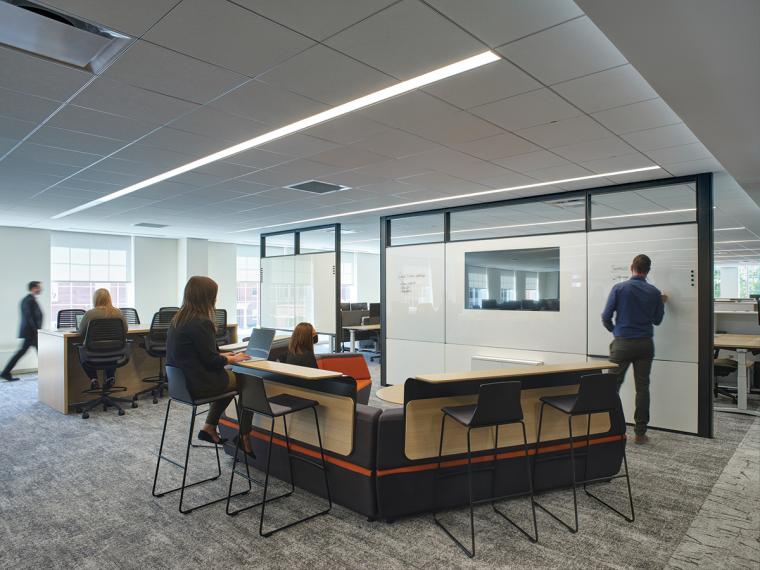
 At the same time we welcome news of multiple highly effective vaccines, the nation is in the midst of a long winter and continued shutdowns. When will the vaccines be available to most citizens? How quickly will they be distributed? How many people will take them? When will they make an impact on day-to-day life? This much is for sure: 2020 was a year of relentless uncertainty, and that uncertainty has extended into the real estate world to our expectations about the future of workplace occupancy patterns. The task ahead for property owners and employers is to successfully negotiate an environment that will almost certainly continue to evolve, perhaps returning more quickly than expected to something like a pre-COVID normal with the notable addition of increased flexibility on remote work.
At the same time we welcome news of multiple highly effective vaccines, the nation is in the midst of a long winter and continued shutdowns. When will the vaccines be available to most citizens? How quickly will they be distributed? How many people will take them? When will they make an impact on day-to-day life? This much is for sure: 2020 was a year of relentless uncertainty, and that uncertainty has extended into the real estate world to our expectations about the future of workplace occupancy patterns. The task ahead for property owners and employers is to successfully negotiate an environment that will almost certainly continue to evolve, perhaps returning more quickly than expected to something like a pre-COVID normal with the notable addition of increased flexibility on remote work.
In New York City, some 10 percent of workers are currently back in the office, while the national average hovers around 25 percent. It is clear that a low level of occupancy will continue, with or without shutdowns, through spring and possibly through summer of 2021. In the meantime, space users and property owners are grappling with how to best manage their businesses and their office space. Employers are seeking to get a handle on the new remote work paradigm as employee attitudes toward work-from-home shift and the impact of isolation on work culture becomes more apparent. A recent Vocon survey revealed that 40 percent of business leaders report a decrease in productivity with remote work and 25 percent report work-from-home fatigue. This is a significant shift from an April 2020 Vocon survey, in which 56 percent of business leaders rated productivity as “excellent.”
The Pros and Cons of Virtual Work
In the last several months, we have learned that employees greatly value choice and flexibility, and that employers will have to accept this. According to the Vocon survey, 27 percent of employers have given their employees the option to work on or off-site. The survey also reveals that employers anticipate a post-COVID world in which more than 50 percent of their employees will opt to work from home for at least two days per week. It is possible, however, that this changes because remote work has a significant impact on an organization’s ability to advance its mission. New and young employees struggle to learn remotely, and workplace culture erodes when employees do not gather in one location. So-called “casual collisions,” in which information is shared and ideas are brainstormed, do not occur over Zoom. While many tasks, such as concentration-heavy research and writing, benefit from uninterrupted quiet time, creativity often requires the noisy, bumpy and ultimately productive process of in-person collaboration. Importantly, remote work may slow or reverse progress made toward diversification in the workplace by preventing people of different backgrounds from getting to know each other so that they can move to a new shared culture.
Businesses must balance these competing issues as they seek to maintain a high level of productivity, fostering growth now and in the future. While each business is unique, a productive work environment and positive company culture are important to all. Moving forward, business leaders will likely embrace a scalable hybrid work structure that incorporates on-site and off-site options best suited to individual employee tasks and goals.
How the New Paradigm Will Shape Office Design
Office designs and workplace strategies will reflect the new circumstance, and flexibility will be critical to adjust to future changes. It is crucial that we provide lasting solutions for building owners and office tenants who seek to optimize performance and maintain high employee engagement. The ideal office design will accommodate the needs of employees who choose to work off-site and those who perform better when working in office spaces together. These office spaces will be reoriented to have fewer dedicated desks and more open spaces for group gatherings that promote collaboration. They may have enhanced technology for spaces that accommodate in-person and remote meetings. The office will remain at the heart of company culture and productivity if it addresses our new reality.
The one thing we now know is that we do not know what will happen, even with structures and ways of life that seem fundamental. While many have hastened to announce the death of the office, for example, the office provides irreplaceable benefits to employers and employees. In fact, it is quite possible that employees who work in the office in the post-COVID world will have a distinct advantage over those who don’t. They will have personal contact with supervisors, providing the opportunity to build powerful relationships through seemingly meaningless interaction. They will learn skills they would not have learned from home, and they will benefit from the ability to socialize with coworkers and other industry contacts. Working in the office may well be viewed as a perk. T&ID

